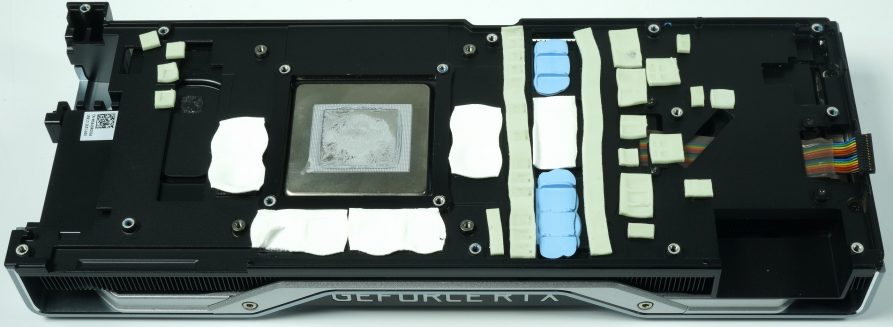Board layout
The board of the new little sister of the GeForce RTX 2080 almost resembles the board of the copy template like one egg to another. It is a design with real 8 (GPU) + 2 (memory) phases and it is cleverly solved, as with the GeForce RTX 2080 Ti. A total of six phases are fed from the external PCIe ports, two from the motherboard slot Equal remains that the PWM controller for the memory is on the top. The positioning of the two phases for the memory can be seen again by the larger inductors of the two coils.
The back is badly paved and you can also see that the socket of the GPU is much smaller than the TU102. The uP9512 on the back is used as an 8-phase PWM controller specifically designed to provide high-precision output voltage systems for the latest generation GPUs. It has programmable output voltage and active voltage positioning functions to adjust the output voltage depending on the load current, so that it is optimally positioned for a good load current transition.
The uP9512 supports NVIDIA Open Voltage Regulator Type 4i+ with PWMVID function. The PWMVID input is buffered and filtered to create a very accurate reference voltage. The output voltage is then precisely controlled on the reference input. The integrated SMBus interface offers enough flexibility to optimize performance and efficiency and also to connect the appropriate software. The controller also supports new Smart Power Stage chips (PLCs). Appropriate PLC then provide very accurate information about e.g. currents (IMON) and temperatures (TMON).
An important feature is the flexible hardware specification to adjust the operating phase number in different load current states. In addition, soft start to avoid peaks, channel current limitation, undervoltage protection, overvoltage protection and power good output. All 8 voltage converter circuits are equipped with the smaller FDMF 3160 from ON Semiconductor, a PowerTrench® MOSFET and equivalent to the original Fairchild, which is hardly documented.
In the case of coils, one again relies on the usual encapsulated ferrite core coils, which this time, however, are rectangular, in order to create more space for the high number of voltage converter circuits with the narrower sides in the vertical line-up of the coils. The label on the memory identifies it as Micron's MT61K256M32. These are 8GB GDDR6 SGRAM modules (2 channels x 256 Meg x 16 I/O, 2 channels x 512 Meg x 8 I/O) with a bandwidth of 14Gb/s. Since a total of eight modules are installed, the memory expansion of 8 GB is also available.
The two phases of the voltage converters, like the GPU, are provided by a uP9512 in a two-phase layout. The same PLC is also used with the two FDMF 3160s. The coils are slightly larger at 470 mH in the inductance, but are completely identical in terms of external dimensions.
The input filtering is carried out via three 1-H coils, wherein there is a suitable shunt in each of the three connection lines. This is a very low-impedance resistance to which the voltage drop is measured in parallel and passed on to telemetry. Thus, the board power can be limited quite exactly to what the manufacturer as a frame for the total power consumption or specified the respective supply line. The Silver Pencil faction will surely shrug nervously.
The following table contains the most important components:
Cooler
The top cover carries the two fans of AVC and it is the usual 7.5 watt models with a maximum of 3700 rpm. Since I also own such modules individually, I have a consumption of approx. 4 watts per airer module on an external controller. Fits and matches my previously determined values
Among them sits the actual cooler with a vapor chamber, as we also know it from the RTX 2080, as well as the slat cooler. This chamber distributes the waste heat over the radiator floor, which works quite well in practice. On the board sits a massive aluminum-cast mounting and cooling frame that cools all active components except the GPU that need to be cooled.
The side lying on the board does not save on pads and so everything is really thermally integrated and not only the large items such as voltage converters and memory. The backplate absorbs the waste heat of some active components, so cool is much more integrated than that of the smaller RTX 2060 Super.
| Cooling system at a glance | |
|---|---|
| Type of cooler: | Air |
| Heatsink: | Vapor Camber |
| Cooling fins: | Aluminum, vertical alignment related |
| Heatpipes | Vapor Camber |
| VRM cooling: | About mounting frame |
| RAM cooling | About mounting frame |
| Fan: | 2x 8.7 cm fan, 2x 9 cm openings No fan stop |
| Backplate | Aluminum Active cooling function |
- 1 - Einführung und Übersicht
- 2 - Tear Down: Platine und Kühler
- 3 - The Division 2
- 4 - F1 2019
- 5 - Far Cry 5
- 6 - GTA V
- 7 - Metro Exodus
- 8 - Shadow of the Tomb Raider
- 9 - Total War: Three Kingdoms
- 10 - World War Z
- 11 - Leistungsaufnahme im Detail
- 12 - Temperatur, Takt, Infrarot
- 13 - Lüfter und Lautstärke
- 14 - Zusammenfassung














































Kommentieren